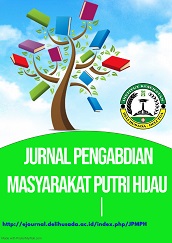EDUKASI SENAM HAMIL DENGAN LAMANYA PROSES PERSALINAN KALA II PADA IBU PRIMIPARA
Abstract
Pregnancy exercise is a way that supports ease of delivery. Pregnancy exercise aims to prepare and train the muscles so that they can function optimally in normal delivery. Pregnancy exercise is intended for pregnant women without abnormalities or without diseases accompanied by pregnancy, namely heart disease, kidney disease, pregnancy complications (pregnancy with bleeding, pregnancy with position abnormalities), and pregnancy accompanied by anemia. This community service aims to provide pregnancy exercise education related to the length of labor in the second stage of labor in primiparous mothers. This community service partner is a primiparous mother with a gestational age of 32 weeks totaling 33 pregnant women. The first activity carried out was by inviting pregnant women to attend pregnancy exercise and distributing leaflets about pregnancy exercise education related to the length of the second stage of labor. Before pregnancy exercise is carried out, pregnant women first take a pre-test. After that carried out pregnancy exercise for 30 minutes. At the end of the session, pregnant women were asked to fill out a post-test and provide an evaluation related to the activities that have been carried out. Furthermore, pregnant women will be observed until delivery arrives by evaluating how often pregnant women do pregnancy exercises. Pregnant women who do pregnancy exercise once a week have a delivery time of < 2 hours as much as 48,5%.
References
Ermala Sari. (2015). Hubungan Pengetahuan dengan Sikap Ibu Hamil terhadap Senam Hamil di Rumah Sakit Elisabet Medan tahun 2014. Jurnal Ilmiah Kebidanan IMELD, Vol. 1 No. 1, Hal: 44-46
Kementerian Kesehatan Indonesia. (2014). Profil Kesehatan Indonesia. Jakarta : Kementerian Kesehatan RI
Kementerian Kesehatan Republik Indonesia. (2017). Survei Demografi Kesehatan Indonesia 2017. Jakarta: Badan Pusat Statistik
SDGs (Sustainable Development Goals). (2015). Program Pembangunan Pemerintah secara Global












